
p-ISSN 1859-4417 e-ISSN 3030-4822
86
Summary
Using widely accepted scientific research methods in sports and physical education, we evaluated
the current practices for testing and assessing learning outcomes in the Aerobics course for Physical
Education majors at Bac Ninh Sports University. The findings reveal that, while the evaluation process
adheres to the Ministry of Education and Training regulations, the assessment content lacks scientific
depth and practical relevance. There is a noticeable misalignment between the course content and
the evaluation criteria, and concerns regarding objectivity and accuracy in the assessments persist.
Keywords: Assessment, Aerobics, Physical Education majors, Bac Ninh Sports University...
(1)PhD, (2)Master, Bac Ninh Sport University
Nguyen Van Thach(1); Nguyen Thi Kim Nga(2)
Bach Phuong Thao(2); Nguyen Thu Trang(2); Dam Danh Phuong(2)
INTRODUCTION
Enhancing the overall quality of education,
particularly the content of the Aerobics course
for Physical Education majors, is a crucial focus
in the training efforts of both the Physical
Education Department and the University.
Recognizing the importance of this, the
department regularly conducts testing and
assessments of student performance in the
Aerobics subject. Building on this foundation,
this research aims to thoroughly evaluate the
current state of the testing and evaluation
processes for Aerobics. By doing so, it seeks to
identify existing gaps and areas for
improvement, allowing for timely adjustments
to ensure that the program's training objectives
are effectively met.
RESEARCH METHODS
In this study, we utilized the following
research methods: document analysis and
synthesis, interviews, pedagogical observation,
and statistical methods.
RESULTS AND DISCUSSION
1. The content of the Aerobics curriculum
for Physical Education majors at Bac Ninh
Sports University
Aerobics is a subject included in the
bachelor's degree program in Physical
Education for Physical Education majors at Bac
Ninh Sports University. It is taught in the second
semester, with a total of 75 hours. This course
equips Physical Education students with both
theoretical knowledge and basic practical skills
in Aerobics. It also provides them with practical
skills, knowledge development, and the ability
to apply this knowledge in teaching and
designing Aerobics lessons.
The Aerobics course is designed based on
training objectives, the nature of the subject, the
time allocation, the knowledge sequence
required for students, student skill levels,
teaching conditions, and practical application
needs. The curriculum is unified with the overall
system of knowledge for the subject. The
program utilizes four main learning methods:
- Theory: This content is taught over 12
periods (16% of the course). This proportion is
appropriate given the subject’s characteristics,
and it complements knowledge from other
courses like Sports Theory and Methodology,
Sports Biomedicine, Psychology, and
Education, which will serve as a solid
foundation for students' future careers.
- Practice: This segment consists of 52
periods, accounting for 69.3% of the total
program duration. The practical component
equips students with specialized Aerobics skills,
including group exercises (Kickfit, Fightfit, Stick
Fighting, Cycling, Bodypump, Corefit,
CURRENT STATUS OF TESTING AND EVALUATING LEARNING
OUTCOMES IN THE AEROBICS SUBJECT FOR PHYSICAL EDUCATION
MAJORS AT BAC NINH SPORTS UNIVERSITY

87
Sè §ÆC BIÖT / 2024
Bodycombat, Bodyjam...), Zumba dance
routines, basic Yoga techniques, and therapeutic
Yoga. The program’s goal is to equip students
with the ability to proficiently perform basic
Aerobics skills for their future professional work.
- Exercise/ Methodology practice: Due to the
unique characteristics of the subject, this
teaching method is not allocated any time in the
program.
- Discussion: The program includes 5 periods
(6.7%) for discussion, which is reasonable given
the needs of the students.
Throughout the course, students must meet
both theoretical knowledge and practical skill
requirements. At the end of each credit, students'
learning outcomes are assessed.
In conclusion, to ensure learning quality,
students must put in great effort during practice and
independent study. The distribution of teaching
methods in the Aerobics course is well-suited to the
nature of the subject and the target audience,
ensuring balance across the course content.
2. Current status of testing and
evaluating learning outcomes in Aerobics
for Physical Education majors at Bac Ninh
Sports University
The Department of Physical Education at
Bac Ninh Sports University uses the following
testing contents:
- Regular evaluation: Regular assessments
(30%):
- Credit 1: Practice combining different
Group X exercise types.
- Credit 2: Practice combining different
Yoga exercise types.
- Credit 3: Theory: Design Aerobics lessons
(Group X and Yoga).
- Final exam: Accounts for 60% of the course
grade. The final task is a prepared Aerobics
lesson (lasting from 7 to 10 minutes) based on
the result of a draw.
Both the regular evaluation and final exam
are graded on a 10-point scale.
The final course grade is a total of all the
Regular evaluation points and the final exam,
weighted accordingly. The final course grade is
converted to a 4-point scale and a letter-grading
scale.
- Final grade = Awareness points (10%) +
Regular assessment points (30%) + Final exam
points (60%).
Over the years, this assessment method has
shown both strengths and weaknesses:
- Strengths: The evaluation content aligns
closely with the main course content.
- Weaknesses: Despite the strengths, several
shortcomings remain:
First, imbalance in content and assessment
requirements: This imbalance is reflected in
having three separate assessments for the
regular assessment, but only one for the final
exam. Moreover, while the course only consists
of 75 periods, 6 of them are allocated solely for
testing.
Second, imbalance in assessment
requirements: in a course with 75 periods,
having three regular evaluations and one final
exam is overwhelming. The students are
required to practice a combination of Group X
exercises, Yoga, and design Aerobics lessons
(Group X and Yoga) during the process
assessments, in addition to preparing a 7-10
minute Aerobics lesson for the final exam. This
is too demanding and does not align with the
student's level, leading to confusion and anxiety
during their studies.
Third, lack of scientific and practical
relevance: As mentioned earlier, the majority of
the content and criteria for assessment are based
on the teacher's subjective judgment rather than
being scientifically calculated in terms of
reliability, validity, and appropriateness. This
can lead to situations where some students may
copy work from peers, resulting in unfair
grading.
Fourth, time-consuming evaluation process:
Currently, the class size for Physical Education
majors ranges from 10 to 15 students, so time
management for assessment activities is not a
significant issue. However, as the student
population grows (e.g., 20 or more students), the
time required for assessment will increase two
or threefold if the same content and methods are
used, becoming a considerable challenge.
The above analysis suggests that the
Department of Physical Education needs to

p-ISSN 1859-4417 e-ISSN 3030-4822
88
consider adjustments and changes to the content
and methods of assessment in Aerobics, making
them more concise, accurate, fair, and objective.
3. Current status of using testing
methods to evaluate learning outcomes in
Aerobics for Physical Education majors at
Bac Ninh Sports University
Through the aforementioned assessment
content, the evaluation of student learning
outcomes in Aerobics is carried out based on the
criteria set by the subject requirements.
- In terms of theory: Evaluation is based on
students' written work and the design of scripts
for a Group X or Yoga exercise routine. The
grading for this is usually done by the course
instructor, following specific standards for each
content section (graded on a 10-point scale).
- In terms of practice: Evaluation is based on
the results of students' performance in the
Aerobics course, compared to the course criteria
(also graded on a 10-point scale). The
assessment method used is the teacher's
subjective observation of factors such as the
execution, fluency, and appropriateness of
movements, the suitability of movement
selection with the background music, and the
accuracy of timing when performing the
exercises. The evaluation results are categorized
into three levels: High, Normal, and Low.
To assess whether the current evaluation
method used by the department ensures
accuracy, objectivity, and alignment with the
course program, we surveyed via questionnaires
with the Department's Physical Education
students. The results are presented in Table 1.
Table 1. Results of student interviews regarding objectivity and accuracy
in the evaluation of Aerobics learning outcomes (n = 51)
No. Interview content
Result
High Normal Low
mi%m
i%m
i%
1Objectivity in evaluating Aerobics learning
outcomes 22 43.1 20 39.2 9 17.6
2Accuracy in evaluating Aerobics learning
outcomes 21 41.2 24 47.1 6 11.8

89
Sè §ÆC BIÖT / 2024
Table 2. Results of interviews evaluating the shortcomings in the process of assessing
the learning outcomes in Aerobics for Physical Education majors at Bac Ninh Sports
University (n=9)
No Shortcomings
Responses
Agree Disagree
mi%m
i%
1The test content does not accurately reflect the
learning content 2 22.20 7 77.80
2Imbalance in testing requirements across
different content areas 8 88.90 1 11.10
3 The test content lacks rigor 7 77.80 2 22.20
4 Lacks scientific and practical aspects 8 88.90 1 11.10
5 Low effectiveness 8 88.90 1 11.10
6 Time-consuming 9 100.00 0 0.00
The results of the interviews with Physical
Education majors, who have completed the
Aerobics course, show that although the majority
of students (82.4% to 88.2%) responded that the
evaluation of Aerobics learning outcomes is
objective and accurate, a significant percentage
(11.8% to 17.6%) indicated that the objectivity
and accuracy of the review remain low. This is an
objective basis highlighting the need for
improvement in the process of evaluating
learning outcomes in Aerobics.
In addition, to gain further practical insight
into the effectiveness of the current evaluation
methods for Aerobics learning outcomes, the
research conducted interviews regarding the
existing issues in the assessment process with 6
full-time teachers and 3 part-time teachers in the
Department (see Table 2).
Table 2 indicates that the statement "The test
content does not accurately reflect the learning
content" was mostly disagreed with by the
teachers. They believe that the test content does
reflect the curriculum. However, the remaining
five issues received high levels of agreement
from the teachers, with agreement rates ranging
from 77.8% to 100%. These issues include an
imbalance in testing requirements across different
content areas; a lack of rigor in the test content;
insufficient scientific and practical value; low
effectiveness; and, finally, the process being too
time-consuming. These are objective reasons
confirming the necessity of revising and
establishing standards for assessing the learning
outcomes of Aerobics for Physical Education
majors at Bac Ninh Sports University.
CONCLUSION
The current state of assessment of Aerobics
learning outcomes for Physical Education
majors at Bac Ninh Sports University over the
years has followed the Ministry of Education
and Training's regulations. It has appropriately
evaluated student performance according to the
course requirements. However, the process still
reveals several shortcomings: an imbalance
between the learning material and test content;
a lack of scientific and practical relevance; a
time-consuming evaluation process; and limited
objectivity and accuracy in the assessments.
REFERENCES
1. Vu Thanh Mai, Dinh Khanh Thu, Pham
Tuan Dung, Luu The Son, Nguyen Huu Hung,
Nguyen Van Hieu (2014), Aesthetic Gymnastics
Textbook, Sports Publishing House, Hanoi.
2. Nguyen Toan and Pham Danh Ton (2000),
Theory and Methods of Physical Education and
Sports, Sports Publishing House, Hanoi.
3. Bac Ninh Sports University - Physical
Education Department (2015), Physical Education
Program for Physical Education Majors in 2015,
Bac Ninh Sports University, Bac Ninh.
4. Nguyen Duc Van (2001), Statistical
Methods in Physical Education and Sports,
Sports Publishing House, Hanoi.
(Received 20/8/2024, Reviewed 24/10/2024, Accepted 28/11/2024
Main responsible: Nguyen Van Thach; Email: thachbmcl@gmail.com)

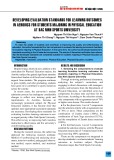

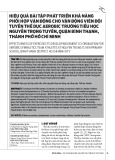
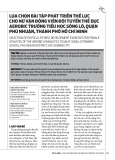
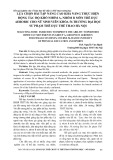
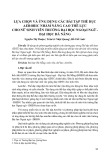



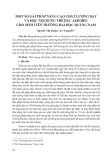




![Bài giảng Vovinam Việt Võ Đạo: Chương 2 - Các điều luật chung [Chi tiết]](https://cdn.tailieu.vn/images/document/thumbnail/2025/20251111/kimphuong1001/135x160/771762853254.jpg)










